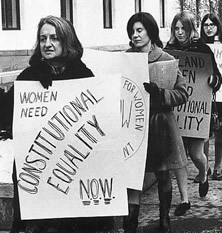
That’s right readers, for my first installment of Working Women and Feminism, I’m talking about the (in)famous Betty Friedan.
*SCREEEEEEEEECH*
But wait…Betty Friedan? The author of The Feminine Mystique? Who so blatantly ignored the problems of low-income women and women of color, and even referred to lesbians as “the lavender menace?” Yes. Believe it or not, Betty Friedan was a huge part of the labor feminist movement prior to writing The Feminine Mystique. So it’s only fitting that I should begin my series by explaining the complex history behind the woman considered to be the mother of Second Wave feminism.
After writing The Feminine Mystique, Betty Friedan did a lot of work rewriting her history. In interviews, she has described herself as completely apolitical prior to writing the book. She claims that it wasn’t until the 1960s that she experience a feminist awakening. And as far as any union or radical activity? Forget it. But as Daniel Horowitz (a former colleague of Friedan’s) uncovers in his book Betty Friedan and the Making of ‘The Feminine Mystique,’ Friedan was deeply involved in radical feminism and labor activism as early as her time at Smith College. At Smith College she was involved in radical, anti-interventionist groups like the American Youth Congress. She wrote papers describing her Marxist, anti-capitalist views. Her senior year, she edited the Smith newspaper, using her power to espouse her anti-interventionist views in spite of immense public support of WWII.
After leaving Smith she attended the University of California at Berkeley where she became further involved with Marxist politics. At this same time, many Americans were coming under investigation for Communistic activities by the FBI. This led into the era of McCarthyism. Many Americans, from professors to actors, were blacklisted and investigated for “un-American” activities. Many academics were silenced out of fear, and even President Truman called many of the bills passed at this time “a long step toward totalitarianism” because it caused many Americans to silence their opinions about the government.
At the height of this second Red Scare, Betty Friedan worked for the United Electrical Workers’ UE News publication. She wrote a number of pamphlets educating working women of color on how they could organize and gain power within their local unions. Unfortunately, after becoming pregnant with her second child, Friedan was fired by the UE for requesting a second maternity leave. Horowitz believes that this greatly disillusioned her with labor activism. At this time, she also lived in a liberal, diverse community in New York called Parkway Village. The community was home to many immigrants from Europe, Africa, and Asia. Betty helped organize community daycares and impromptu summer camps for all of the children. When the landlord threatened to end rent control, she rallied the community into political action. Eventually, she moved to the suburbs and a few years later wrote her influential first book.
So why did Friedan work so hard to hide her past? Why did she insist that she had no political involvement when she was clearly a radical activist for a number of years? According to Horowitz, Friedan probably did much of this out of fear. McCarthyism silenced an entire generation of activists, and Friedan was a part of this group. She undoubtedly feared that if her past were to come out it would not only harm herself and her family, but also the feminist movement. Friedan understood the importance of appealing to the American mainstream, which at the time was suburban housewives. If it came out that the leader of this movement was a former radical and potential Communist, she would have lost a great deal of support from important and influential backers.
Yet in many ways, Friedan still advocated for working women. She tried to push feminists to focus on economic issues such as economic equality and government provisions for daycare. Both of these actions would greatly help working women, even in 2012. I believe that learning more about Betty Friedan’s past, as well as the history of the early Cold War, would help many feminists to understand the roots of modern feminism, and why it took what some consider a more conservative turn in the 1960s.

I did learn about Betty Friedan in my Intro to Women’s Studies class. It’s interesting to note that she did help the feminist movement when she’s most well-known for The Feminine Mystique. She’s probably one of many women who hid certain parts of their past due to fear. Thanks for the educational post!
LikeLike
I have heard about Betty Friedan quite frequently but never really had a solid idea of what she was actually “about.” I really enjoyed reading this post because it shed a new light on not only Betty, but Second Wave Feminism too, awesome job!
LikeLike